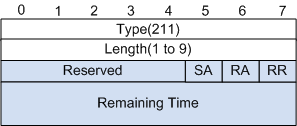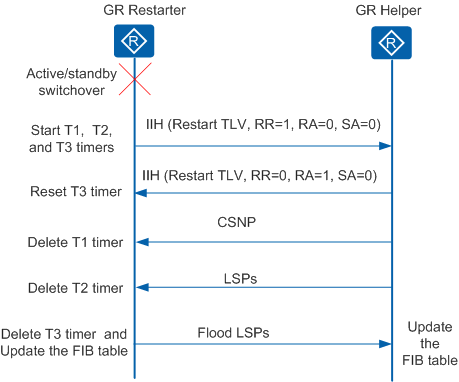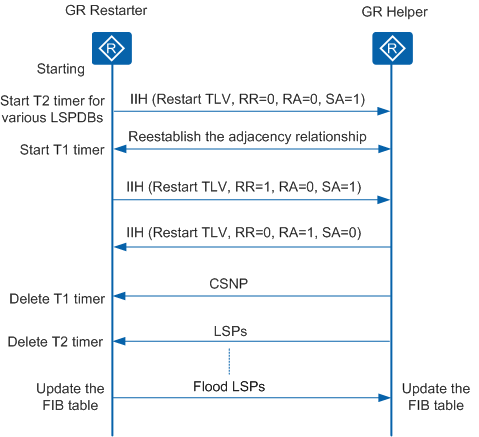IS-IS GR
IS-IS graceful restart (GR) is a high availability technology that implements non-stop data forwarding.
After the master/slave switchover, no neighbor information is stored on the restarted router. The first Hello packets sent by the router after restart do not contain the neighbor list. After receiving the Hello packets, the neighbor checks the two-way neighbor relationship and detects that it is not in the neighbor list of the Hello packets sent by the router. The neighbor relationship is interrupted. The neighbor then generates new LSPs and floods the topology changes to all other routers in the area. Routers in the area calculate routes based on the new LSDBs, which leads to route interruption or routing loops.
The IETF defined the GR standard, RFC 3847, for IS-IS. The restart of the protocol is processed for both the reserved FIB tables and unreserved FIB tables. Therefore, the route flapping and interruption of the traffic forwarding caused by the restart can be avoided.
Concepts
IS-IS GR involves two roles, namely, GR restarter and GR helper.
GR restarter: is a device that has the GR capability and restarts in GR mode.
GR helper: is a device that has the GR capability and helps the GR restarter complete the GR process. The GR restarter must have the GR helper capability.
To implement GR, IS-IS uses TLV 211 (restart TLV) and three timers, T1, T2, and T3.
Restart TLV
The restart TLV is an extended part of an IS-to-IS Hello (IIH) PDU. All IIH packets of the router that supports IS-IS GR contain the restart TLV. The restart TLV carries the parameters for the protocol restart. Figure 1 shows the format of the restart TLV.
Table 1 describes the fields of the restart TLV.
Field |
Length |
Description |
|---|---|---|
Type |
1 byte |
TLV type. Type value 211 indicates the restart TLV. |
Length |
1 byte |
Length of value in the TLV. |
RR |
1 bit |
Restart request bit. A router sends an RR packet to notify the neighbors of its restarting or starting and to require the neighbors to retain the current IS-IS adjacency and return CSNPs. |
RA |
1 bit |
Restart acknowledgement bit. A router sends an RA packet to respond to the RR packet. |
SA |
1 bit |
Suppress adjacency advertisement bit. The starting router uses an SA packet to require its neighbors to suppress the broadcast of their neighbor relationships to prevent routing loops. |
Remaining Time |
2 bytes |
Time during which the neighbor does not reset the adjacency. The length of the field is 2 bytes. The time is measured in seconds. When RA is reset, the value is mandatory. |
Timers
Three timers are introduced to enhance IS-IS GR: T1, T2, and T3.
T1: If the GR restarter has already sent an IIH packet with RR being set but does not receive any IIH packet that carries the restart TLV and the RA set from the GR helper even after the T1 timer expires, the GR restarter resets the T1 timer and continues to send the restart TLV. If the ACK packet is received or the T1 timer expires three times, the T1 timer is deleted. The default value of a T1 timer is 3 seconds.
Any interface enabled with IS-IS GR maintains a T1 timer. On a Level-1-2 router, broadcast interfaces maintain a T1 timer for Level-1 and Level-2 neighbor relationships.
T2: is the time from when the GR restarter restarts until the LSDBs of all devices of the same level are synchronized. T2 is the maximum time that the system waits for synchronization of all LSDBs. T2 is generally 60 seconds.
Level-1 and Level-2 LSDBs maintain their respective T2 timers.
T3: is the maximum time during which the GR restarter performs GR. The T3 initial value is 65535 seconds. After the IIH packets that carry the RA are received from neighbors, the T3 value becomes the smallest value among the Remaining Time fields of the IIH packets. If the T3 timer expires, GR fails.
The entire system maintains a T3 timer.
Session Mechanism
For differentiation, GR triggered by the master/slave switchover or the restart of an IS-IS process is referred to as restarting. In restarting, the FIB table remains unchanged. GR triggered by router restart is referred to as starting. In starting, the FIB table is updated.
The following describes the process of IS-IS GR in restarting and starting modes:
Figure 2 shows the process of IS-IS restarting.
After performing the protocol restart, the GR restarter performs the following actions:
Starts T1, T2, and T3 timers.
Sends IIH packets that contain the restart TLV from all interfaces. In such a packet, RR is set to 1, and RA and SA are set to 0.
After receiving an IIH packet, the GR helper performs the following actions:
Maintains the neighbor relationship and refreshes the current Holdtime.
Replies with an IIH packet containing the restart TLV. In the packet, RR is set to 0; RA is set to 1, and the value of the Remaining Time field indicates the period from the current moment to the timeout of the Holdtime.
Sends CSNPs and all LSPs to the GR restarter.

On a P2P link, a neighbor must send CSNPs.
On a LAN link, only the neighbor of the DIS sends CSNPs. If the DIS is restarted, a temporary DIS is elected from the other routers on the LAN.
If the neighbor does not have the GR helper capability, it ignores the restart TLV and resets the adjacency with the GR restarter according to normal IS-IS processing.
After the GR restarter receives the IIH response packet, in which RR is set to 0 and RA is set to 1, from the neighbor, it performs the following actions:
Compares the current value of the T3 timer with the value of the Remaining Time field in the packet. The smaller value is taken as the value of the T3 timer.
Deletes the T1 timer maintained by the interface that receives the ACK packet and CSNPs.
If the interface does not receive the ACK packet or CSNPs, the GR restarter constantly resets the T1 timer and resends the IIH packet that contains the restart TLV. If the number of timeouts of the T1 timer exceeds the threshold value, the GR restarter forcibly deletes the T1 timer and turns to the normal IS-IS processing to complete LSDB synchronization.
After the GR restarter deletes the T1 timers on all interfaces, the synchronization with all neighbors is complete when the CSNP list is cleared and all LSPs are collected. The T2 timer is then deleted.
After the T2 timer is deleted, the LSDB of the level is synchronized.
In the case of a Level-1 or Level-2 router, SPF calculation is triggered.
In the case of a Level-1-2 router, determine whether the T2 timer on the router of the other level is also deleted. If both T2 timers are deleted, SPF calculation is triggered. Otherwise, the router waits for the T2 timer of the other level to expire.
After all T2 timers are deleted, the GR restarter deletes the T3 timer and updates the FIB table. The GR restarter re-generates the LSPs of each level and floods them. During LSDB synchronization, the GR restarter deletes the LSPs generated before restarting.
At this point, the IS-IS restarting of the GR restarter is complete.
The starting device does not retain the FIB table. The starting device depends on the neighbors, whose adjacency with itself is Up before it starts, to reset their adjacency and suppress the neighbors from advertising their adjacency. The IS-IS starting process is different from the IS-IS restarting process, as shown in Figure 3.
- After the GR restarter is started, it performs the following actions:
Starts the T2 timer for the synchronization of LSDBs of each level.
Sends IIH packets that contain the restart TLV from all interfaces.
If RR in the packet is set to 0, a router is started.
If SA in the packet is set to 1, the router requests its neighbor to suppress the advertisement of their adjacency before the neighbor receives the IIH packet in which SA is set to 0.
- After the neighbor receives the IIH packet that carries the restart TLV, it performs the following actions depending on whether GR is supported:
GR is supported.
Re-initiates the adjacency.
Deletes the description of the adjacency with the GR restarter from the sent LSP. The neighbor also ignores the link connected to the GR restarter when performing SPF calculation until it receives an IIH packet in which SA is set to 0.
GR is not supported.
Ignores the restart TLV and resets the adjacency with the GR restarter.
Replies with an IIH packet that does not contain the restart TLV. The neighbor then returns to normal IS-IS processing. In this case, the neighbor does not suppress the advertisement of the adjacency with the GR restarter. On a P2P link, the neighbor also sends a CSNP.
After the adjacency is re-initiated, the GR restarter re-establishes the adjacency with the neighbors on each interface. When an adjacency set on an interface is in the Up state, the GR restarter starts the T1 timer for the interface.
After the T1 timer expires, the GR restarter sends an IIH packet in which both RR and SA are set to 1.
After the neighbor receives the IIH packet, it replies with an IIH packet, in which RR is set to 0 and RA is set to 1, and sends a CSNP.
After the GR restarter receives the IIH ACK packet and CSNP from the neighbor, it deletes the T1 timer.
If the GR restarter does not receive the IIH packet or CSNP, it constantly resets the T1 timer and resends the IIH packet in which RR and SA are set to 1. If the number of the timeouts of the T1 timer exceeds the threshold value, the GR restarter forcibly deletes the T1 timer and turns to the normal IS-IS processing to complete LSDB synchronization.
After receiving the CSNP from the helper, the GR restarter synchronizes the LSDB.
After the LSDB of this level is synchronized, the T2 timer is deleted.
After all T2 timers are deleted, the SPF calculation is started and LSPs are regenerated and flooded.
At this point, the IS-IS starting of the GR restarter is complete.


